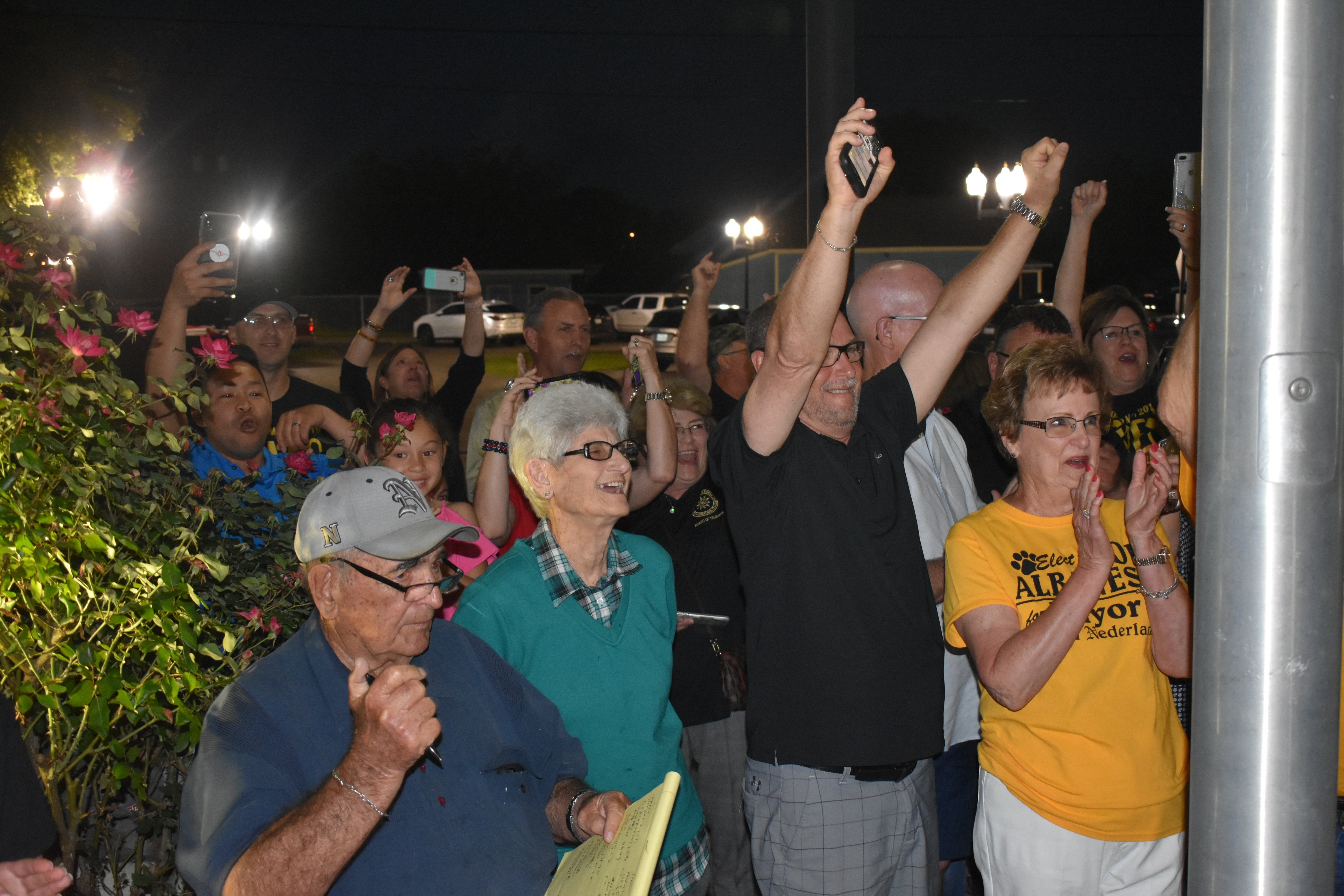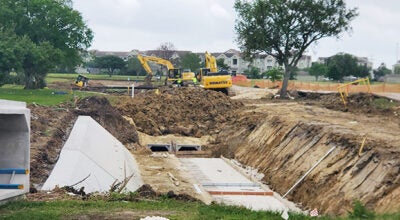New schools: Nederland voters say it was time
Published 10:53 am Monday, May 13, 2019

- A crowd erupts outside of the Nederland City Hall as the 2018 NISD bond election results are read.
By Chris Moore
chris.moore@panews.com
NEDERLAND — With nearly 50 people crowded outside City Hall, city and school district officials read the results of the May 4 election. Many cheered as the results of the city election revealed Don Albanese would become mayor.
However, it was not necessarily the contested mayoral race that brought people to the polls or to City Hall. The Nederland Independent School District bond was the reason Nederland voters went to the polls in record numbers.
With a once talkative crowd silent, the district official began to read the results of the bond election. For proposition A, the bond that would build a new high school and provide upgrades and improvements to all of the other campuses, 2,514 voted in favor. The official could only get out that the first digit of votes against the proposal was “1” before the crowd erupted into cheers as though they had just witnessed a game-winning basketball shot. Opposing: 1,459.
For the icing on the cake, proposition B, which would upgrade Bulldog Stadium, passed 2,548 to 1,417.
Building leaders
Many in the crowd were wearing black shirts with gold check marks and “yes” in big letters. They were members of Building Tomorrow’s Leaders, a group created to encourage voters to support the bond. Many of the members were also on the Citizens Advisory Committee, created by the school board to make a proposal to the board about which projects to pursue with the bond election in a process that took eight months to accomplish.
For a decade, the school district had tried to pass bonds that would build new facilities but to no avail.
In July, the board of trustees heard a presentation from Templeton Demographics, which did a study on the district. The study concluded that the number of students in the district would gain 1,177 students over the next 10 years.
After the numbers came out, the district announced the first meeting of the Citizens Advisory Committee. School board president Suzanne Isom told The Port Arthur News the district needed new facilities to accommodate growth for the present and for the future of the district.
Some 80 concerned citizens met for the first time in the high school cafeteria. The group was told they would tour all of the campuses hosted by a principal or another member of the staff of their respective schools. The group met once a month for six months.
Eyes on
On tours, principals showed committee members cramped classrooms and offices along with leaky ceilings and antiquated layouts. After the tours, the committee met up in the cafeterias to discuss what they saw and drew up plans.
During the first meeting, members were given an agenda and a plethora of information, including the Templeton Demographic study.
District-hired consultant Robert Nicks worked alongside the committee and guided them through the process. He told the committee what would be required to get a bond passed and made the members pledge to “follow the data.”
The Houston-based architect group IBI also offered insight to the cost and timetable of each product. The group was involved early, providing numbers so the committee could come up with proposals to put on a community survey, which was designed to gauge interest of those who live within the district.
IBI recently built schools in nearby Hamshire-Fannett and Dewyville.
Long meetings
Meetings often lasted more than three hours. During the third meeting, members broke off into groups to discuss proposals. Some wanted new elementary schools. Some wanted a new high school. With price estimates in hand, the members discussed a range of possibilities.
Some were concerned about the pricetag getting too high. One table was cautious to go over $120 million, which was the price tag at which the previous bond failed. Even with all of the different possibilities and opinions there remained a constant among the people in that cafeteria — a new campus was a must. Another concern that popped up was that the idea that the data provided to the committee from Templeton Demographics might not be accurate. During the meeting, Nicks mentioned that the growth numbers might not be as aggressive as previously thought, which was news to the committee.
After filing a Freedom of Information Act Request, The Port Arthur News received a new Templeton Demographic Study that projected 738 additional students over the next decade instead of 1,177 previously estimated.
The oldest campus in the district was Langham Elementary at 79 years old; the newest was the high school, built 47 years ago.
During the fourth meeting, the CAC was presented a list of survey questions that would go out to the community. The committee spent a couple of hours going over each question to make sure the wording was to their liking.
Survey says
On Feb. 11, the survey went live to the community. At the next meeting, the committee pored over results to see how the community had responded to their proposals. The survey, created and analyzed by Geoff Tonini of Decisive Campaigns, identified two projects as a risk/concern of weakness — athletic program improvements and the new high school.
In the information provided to the members, the data showed voters 65 and older were more likely to vote and more likely to oppose the new high school. The data showed that age range found the new high school proposal less favorable than athletic program improvements, which did not make the final proposal. However, all proposed projects received favorable results.
During the final meeting, the members had to make a decision on which projects would go before the board. With the room largely split on whether to propose four new elementary schools at the price of $92 million, or a new high school at the price of $82 million, the committee once again wanted to make sure they had the same goal.
One of the members asked for a show of hands to see who wanted a new facility in the district. Everyone raised their hands.
At the next meeting, five members presented the proposal to the board. On the list was a new high school, upgrades to the elementary and middle schools, which would allow fifth grade to be at the elementaries, upgrades to the technology and safety and security and upgrades and improvements to the stadium.
The stadium was given its own proposition so detractors could not say a disproportional amount was going towards athletics. The CAC was wary about pushback to the stadium and to the bond as a whole.
Old wounds
They had good reason to be cautious. Many Nederland residents talk about a committee hiring a “professional bond beater” in 2009 to hand out information discouraging those to vote in favor. In 2012, the board broke the bond into four proposals: Two would provide upgrades to the existing campuses and two would build new campuses. Once again, the voters decided to go with improvements of new buildings.
This time felt different to many in the committee. There was no grand, organized opposition. There were streets signs opposing and bloggers and Facebook posts telling people to vote against it. However, the street signs opposing the bond were far outnumbered by those in favor.
The blogs and social media posts were outnumbered as well. Still, rumors swirled about voters and storeowners being afraid to publicly oppose the bond in fear of retaliation, which led many to wonder if there was, in fact, some silent majority.
The election revealed that there was not a majority of any kind that opposed the bonds, unless their vote was silent as well.
For the CAC members celebrating in front of City Hall on May 4, the joy was overwhelmed by relief. Not only did the bonds pass, but hard work they put in paid off. The election results largely matched what the survey results predicted.
In the middle of the crowd was Lori Bell, who was a member of the CAC and the Building Tomorrow’s Leaders.
When asked what was different from a decade ago, she said, “I think it was the fact we’ve been waiting a decade. We knew it was time.”





